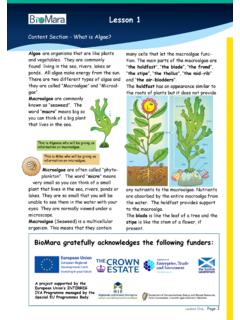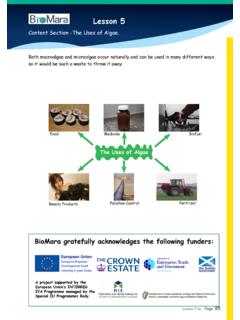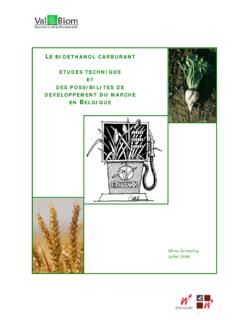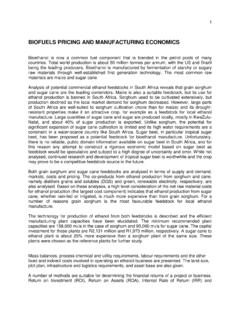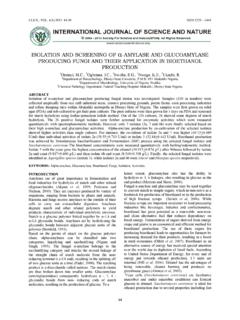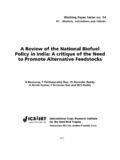Transcription of Lesson 6 - BioMara
1 A project supported by the European Union s INTERREG IVA Programme managed by the Special EU Programmes gratefully acknowledges the following funders: Lesson 6 From Lesson 5 you have discovered that there are many uses for algae. You also have discovered that algae can be used to produce biofuels. Biofuels are fuels that are made from is material from living or recently living organisms. Some common examples of biomass are algae, grass and wood. Biomass can be used to make biofuels. There are three common types of transport biofuels in Europe; bioethanol , biodiesel and biogas. bioethanol is mixed with petrol, biodiesel is mixed with diesel and biogas (methane) can be used to fuel specially adapted vehicles.
2 These three types of biofuel can be produced from Biofuels are made from biomass. These biofuels can all be produced from this section you will learn how all three different biofuels are made using can be made from oils within the algae. As we learned in a previous Lesson , micro-algae contains oil within its cell. This oil can be used to make biodiesel. There are different varieties of microalgae which contain oil. The scientists that make the biodiesel try to identify the species of microalgae that have the most oil within their cells and also the microalgae that grows best within its environ-ment. Some microalgae have lots of oil, but are very fragile and so will not grow well at large scales.
3 Once grown, the oil is removed from the microalgae using chemicals or by squeezing oil out of the cells using scientific equipment. Then the oil is used as an ingredient in biodiesel. This oil is changed chemically from plant oil to biodiesel. The finished product can be used on its own as pure biodiesel but is normally mixed with ordinary diesel and used directly in cars. There is biodiesel in most mineral diesel on sale in Europe but it makes up less than 5% unless otherwise Section - How Algae can be used to produce Six. Page 103 Lesson Six. Page 104 BioethanolBioethanol is used in petrol. Ethanol is better known as alcohol. The word bioethanol means ethanol that can be made from biomass mainly for transport use.
4 Macroalgae can be used to make bioethanol . Macroalgae that contain a high amount of sugar are used in the production of bioethanol . The macroalgae are cut and treated to free up the sugars within the algae. These sugars decom-pose to a simple sugar called glucose . The macroalgae is now a feedstock for the next is then added to the process. During this time there is a chemical reaction produced by the yeast called fermentation . Fermentation is when the yeast uses glucose and produces ethanol and other components. The ethanol is then separated from the other components by heating it up until it boils and then cooling the vapours. This is called distillation. The bioetha-nol undergoes a further filtering process to remove water so it can then be used as an ingredient with is produced naturally from the break-down of organic material.
5 The main constitutent in biogas is methane gas. Macroal-gae can form biogas because of its high sugar content. It is washed, mashed up and treated and then becomes the feedstock . The feedstock then enters big tanks. At this stage special micro-organisms called anaerobes are added when conditions are correct. These micro-organisms are special because they live and work without oxygen. They use the feedstock for their food and there are a series of chemical reactions which happen in this environment called Anaerobic Digestion . When the feedstock undergoes anaerobic digestion by the micro-organisms they produce methane gas. Anaerobic Digestion literally means eating without oxygen.
6 For the micro-organisms to survive and the anaerobic digestion to produce gas the environment must be correct. The environment consists of no oxygen (air), correct temperature and anaerobic digestion results in the production of meth-ane gas and carbon dioxide (C02). They can be produced in a 50:50 ratio but normally there is a little more methane than biogas. The biogas can then be burned directly in an engine or a cooker or upgraded for use in car engines or for generating electricity, The remaining sludge in the anaerobic digester can be used as a of using algae as biofuelBiofuels have many advantages as sources of renewable energy. Algae occur naturally, grow quickly and produce oxygen by photosynthe-sis.
7 Macroalgae don t grow on land and so do not compete with land based plants which are normally used for food. Therefore macroalgal biofuels have little effect on farms or food supplies. Biofuels reduce air pollution. They are described as carbon neutral . This means that carbon dioxide is used by algae and plants from the atmosphere during photosynthesis to make their own food but the same amount of carbon dioxide is also returned to the atmosphere when used as a biofuel. This means that addi-tional carbon dioxide is not being added to the atmosphere that is not fixed again in the near future in macroalgae we know that burning fossil fuels such as petrol or coal increase pollution and increasescarbon dioxide.
8 Carbon dioxide is a greenhouse gas and governments throughout the world would like us to reduce the amount of green-houses gases and pollution. Using biofuels could help to reduce the amount carbon dioxide in the Six. Page 105 Lesson 6: How to use algae as Summary Aim: The aim of this Lesson is to show how algae can be used as biofuel and briefly illustrate the 3 different methods of production of biogas, biodiesel and bioethanol . Biofuels - are made from biomass. Biomass is material from living or recently living or-ganisms. Examples of biomass are grass, wood and algae. Both macroalgae and microalgae are involved in the production of biofuel. The word biofuel means fuel that is made from biomass.
9 Biofuel is a term used to describe biodiesel, bioethanol which is used in petrol and methane gas which is found in - Microalgae are involved in the production of biodiesel. Microalgae are chosen for the production of biofuel based on their oil content. The oil inside the microalgae is removed from algae by chemical means or either squeezed out. The oil is collected and changed chemically and is then used as an ingredient in biodiesel. bioethanol bioethanol is an ingredient used in the production of petrol. Macroalgae that contain a lot of sugar are chosen. Macroalgae are cut, mashed and treated. The macroalgae now appear as sludge and is called micro-organisms called Yeast are added at this stage.
10 Yeast uses the feedstock as food and breaks down the feedstock into ethanol and other components. This process is called fermentation. Ethanol is separated from the other components and then the ethanol is used in Methane is the main ingredient in the production of biogas. Methane gas can be produced by using macroalgae. The macroalgae must have a high sugar content. Macroalgae are cut and mashed. Micro-organisms convert the natural sugars in macroalgae into glucose. The macroalgae now appear as sludge and is called feedstock. The feedstock will go into a big tank and special micro-organisms called anaerobes are added. These micro-organisms are special because they don t need oxygen to survive.
